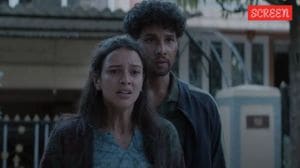An iftar walk at Jama Masjid with author-historian Sohail Hashmi
As the forecourt fills up with people, carrying floor mats and food to share with one another, writer and historian Sohail Hashmi takes us through the food street, a beehive of restaurants, cart vendors, stalls and squatters.
 Historian Sohail Hashmi (left) said most of these shops came up after the 1950s to cater to the new inhabitants. (Photo: Prem Nath Pandey)
Historian Sohail Hashmi (left) said most of these shops came up after the 1950s to cater to the new inhabitants. (Photo: Prem Nath Pandey)“Mohabbat ab sharbat ban gayi hai, nafrat ko bhulao (Love has now dissolved into a sherbet, let’s forget hatred),” says Asif Qureshi, pouring milkshake into a tumbler and offering it to everybody making their way to Jama Masjid to break their Ramzan fast. With a smile on his face, he churns the milk with the juiciest bits of watermelon, dunking in blocks of ice before the sweltering heat can melt them. The refreshing drink washes away every anxiety under the dulcet glow of the masjid dome as the muezzin waits to strike the gong for iftar.
As the forecourt fills up with people, carrying floor mats and food to share with one another, writer and historian Sohail Hashmi takes us through the food street, a beehive of restaurants, cart vendors, stalls and squatters. It is a multi-sensory experience of food — the splashy tang of fruits, the sweet aroma of milk curdling in vats, and the smoky aroma of half-roasted meats. “This street has an unparalleled array of produce, be it fruits and nuts from around the world, vegetarian spreads of chaats, savouries, confectionery, sweetmeats, breads, flower syrups and lassis and, of course, an extensive non-vegetarian platter,” he says as he shows us a variety of dates from Rajasthan, Afghanistan, Algeria, Morocco, Iraq and Iran.
 Asif Qureshi churns the milk with bits of watermelon. (Express Photo: Prem Nath Pandey)
Asif Qureshi churns the milk with bits of watermelon. (Express Photo: Prem Nath Pandey)
And there’s logic in breaking the day-long fast with dates. “You thirst for water and that fills up your belly all too soon. Dates help you transition to the heavy meal, besides having disease-fighting properties,” says 72-year-old Hashmi. Having mapped the trellis of the Old City, from a forlorn corner to rich havelis, he is a true heritage keeper, conducting walks for both children and adults.
Hashmi takes us past shops selling heaps of pheni, cobweb-like rings of the finest vermicelli heaped up like tyres. “This is perfect sehri food, the dawn meal that’s had before fasting. Dropped in hot milk, it dissolves quickly.
 A shop selling heaps of pheni, which is a cobweb-like ring of vermicelli heaped up like tyres. (Express Photo: Prem Nath Pandey)
A shop selling heaps of pheni, which is a cobweb-like ring of vermicelli heaped up like tyres. (Express Photo: Prem Nath Pandey)
Made of maida, it is heavy but sits easily on the stomach because you have it in small bowls. You don’t feel thirsty through the day,” he says, picking up an old Delhi speciality of khajla. This one is a crispy, flaky, puffed up, giant poori, which is dropped in milk with a sprinkle of sugar, again, a complete meal. As cooks ready their griddle for preparing the freshest country chicken and river sole tikkas at Rafiq’s, pakoras of leafy greens sizzle on the other side. And it is in this tehzeeb of culinary confluence that street food in Old Delhi patented the keema gujia and the keema samosa.
Inside the masjid, the gong has been struck, the lights come on and families, the old and the young, pass the food trays around, merrily having what each has to offer, from home-cooked food to street eats, even biscuits and juices. Says Hashmi, “The tradition of a commune-like iftar feasting is fairly recent. But it is a great way of building camaraderie, making friends and children just love it. Nobody feels alone during the difficult time of fasting.” It is a heaving mass of humanity united in prayer and spirit, drawing everybody in, no questions asked.
The food street, too, came up at the turn of the last century. “Historically, eating out was looked down upon because of social hierarchies. Intermingling wasn’t allowed. For Hindus, it was caste. Muslims had a deep cleavage between the high-born and low-born. These parts were largely inhabited by the artisanal community, lower down in the pecking order, and the area had not been gentrified. These shops were meant for travellers, who came to the city to pick up supplies in bulk. Local Dilliwallas never bought anything here. Things changed with the British Raj shifting capital in 1911. Construction began in Kingsway camp and in New Delhi. So, a row of hotels and inns came up around the periphery of the Jama Masjid, where overseers, contractors and material suppliers stayed. The labourers slept on the grounds here, as New Delhi was a wilderness. Food stalls came up for labourers and then the overseers and supervisors also had their meals here.”
A sociological change happened post-1947 when the Punjabi settlers came in and normalised the culture of eating out. “Most of the Khatri families were followers of the Arya Samaj and stopped eating meat at home. Women would follow vegetarianism as they visited temples regularly. But the men needed their drinks with meat and would come here. Most of these shops came up after the 1950s to cater to the new inhabitants,” says Hashmi. Over time, there were other settlers, like the Kashmiri Muslim migrants, mostly belonging to the houseboat, transport, packaging and fruit trade, who fled as militancy robbed them of their livelihood. That’s how Kashmiri restaurants developed from just “hole-in-the-walls”. Now, neat little cafes like Ebony right behind the Masjid cater to the younger, aspirant crowd who want to break their fast over pizzas, pastas and hazelnut coffees instead of chai.
 Iftar at Delhi’s Jama Masjid. (Express Photo: Prem Nath Pandey)
Iftar at Delhi’s Jama Masjid. (Express Photo: Prem Nath Pandey)
As food gives way to prayers, with some devotees performing rituals till the break of dawn, the food street never sleeps. At Rehmatullah’s, the scent of spices spirals out of the cauldron of the thick meat broth or yakhni, considered to be a healing food for Ramzan. The whole spices are wrapped and tied in a muslin cloth to make a potli and dipped into the pot. Once the aroma of the spices has been absorbed by the meat and rice, the potli is taken out and the rice is cooked on a slow coal fire. Of course, the distinct influence of the Mughal courts lies in the nihari, which the shahi khansama and the shahi hakim of emperor Shah Jahan invented in the 17th Century to build immunity against a virulent flu. The robust spice-packed meat stew, slow-cooked overnight, is still the favourite.
While the grilled delicacies and kebabs smoke up over red-hot charcoal, there’s no dearth of the soft and spongy dahi vada, chole or chane ki daal. “What everybody forgets is that the jewellers here hold a food festival featuring no less than 150 chaats during Dussehra or Diwali,” says Hashmi.
It is said that Ramzan is the time to “break free from the deceptions of this world and indulge in the sweetness of imaan”. And what better way to do it than indulge in old Delhi specialities like imartis, balushahis, the nut-crusted sheermals and the distinctive paneer jalebi. “This, the khoya samosa and the classic black jalebi made of mawa (evaporated milk solids) are made here only this time of the year. So that the aftertaste stays with you,” says Hashmi, who always ends his heritage walks for visitors with some sweet talk. If the food is about a celebration of the five senses, then harmony sits in a corner with the Hindu Kanya Vidyalaya adjacent to the house of the baoli keeper of the Jama Masjid. It was started by Dr Annie Besant to localise girls’ education in the neighbourhood. As they say, good food is fuel for the soul.












